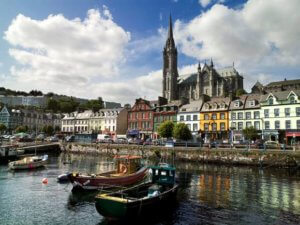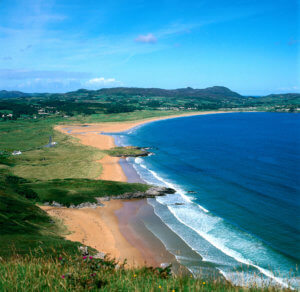Does the idea of visiting 6 of Ireland's coolest lighthouses fascinate you?
Would you stay in one if you could?
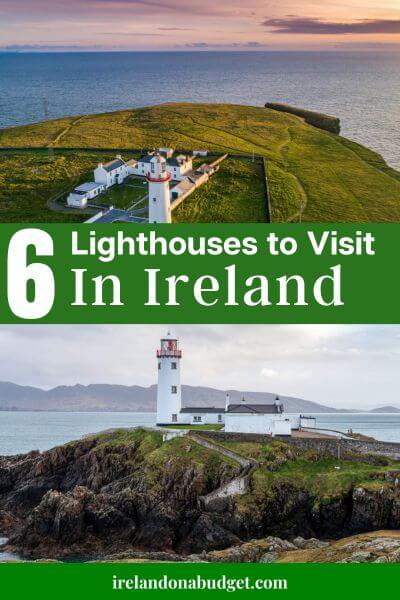 This post and page contain affiliate links and I may earn compensation when you click on the links at no additional cost to you.
This post and page contain affiliate links and I may earn compensation when you click on the links at no additional cost to you.
Ireland has a total of 13 lighthouses scattered around the island of Ireland operated by the Commissioners of Irish Lights, the general lighthouse authority for some of the lighthouses on the island and its adjacent seas and islands.
They include lighthouses in counties Antrim, Clare, Cork, Donegal, Down, Kerry, Mayo, Wexford, and Wicklow.
Take an Aer Lingus Vacation in 2024 – airfare, car rental, and accommodation Included
According to the Great Lighthouses of Ireland, a tourism trail established in 2015 that has brought some well-deserved attention to the country’s lighthouses, a light of sorts was used as early as the 5th century by a monk named St. Dubhan to prevent shipwrecks along the coast.
In the 1600s, the first actual lighthouse was built.
The cottage-style structure was lit by means of a coal-fired, roof-top brazier.
The ruins of the lighthouse can be found close to the Old Head of Kinsale.
While all of the country's lighthouses are cool in their own right, here are 6 of Ireland’s coolest lighthouses, some of them also serving as accommodation.
#1: Loop Head Lighthouse, Co. Clare
The Loop Head Peninsula in County Clare is where you’ll find the Loop Head Lighthouse, which is south of the popular Cliffs of Moher.
There has been a lighthouse on this spot since 1670. Back then, it was more of a coal-burning container on top of a building that was used to shine a light for passing ships.
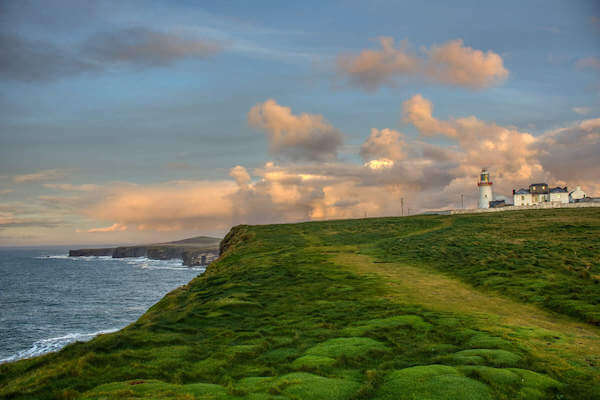
The first actual lighthouse tower was built in 1802 and a more modern one was constructed in 1854.
At the time, it emitted a fixed light. In 1869, it was transformed into a flashing light that operated four times every 20 seconds.
The lighthouse was converted to electricity in 1971.
Today, you can take a guided tour of the lighthouse to learn more about its history. There are several interactive exhibits in the nearby lightkeeper's cottage to add to the experience.
But perhaps what’s more exhilarating is the view that you’ll get from the top of the lighthouse, as far south as the Blasket Islands off the coast of Co. Kerry and to the north, the Twelve Pins mountain range in Connemara, Co. Galway.
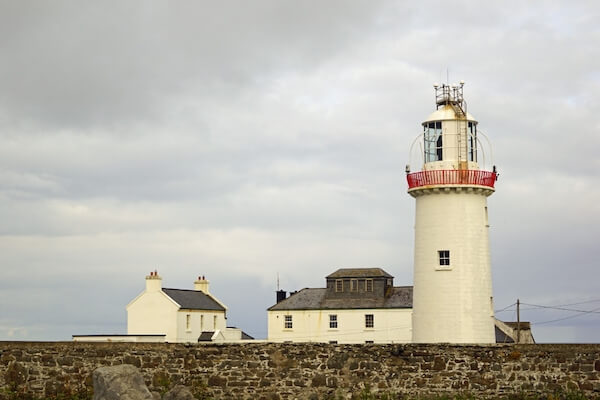
Accommodation is available in the lightkeeper’s house, which is managed by the Irish Landmark Trust.
Accommodation for 5 people costs €572/$613 for two nights, which is the minimum stay allowed.
One dog is allowed.
The accommodation includes all the modern-day conveniences that you would expect of any B&B or hotel.
You can make your reservation on the Irish Landmark Trust website.
About the Loop Head Peninsula:
The Loop Head Peninsula in southwest Clare is a scenic coastal drive that takes in the coastal villages of Kilrush, Carrigaholt, Kilbaha, Loop Head, Kilkee, and Kilrush.
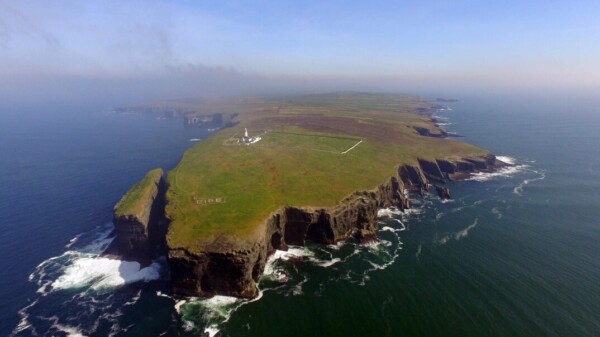
The entire drive is about 81 km (50 miles), with panoramic cliff views to be seen. If you’re an outdoors enthusiast, the region offers opportunities for sea kayaking, sailing, scuba diving, and shark fishing.
#2: Rathlin West Lighthouse, Co. Antrim
The Rathlin West Lighthouse is located on Rathlin Island off the coast of Co. Antrim in Northern Ireland.
It is the only inhabited offshore island in the province.
The Inishowen peninsula in Co. Donegal is off to its west and the Mull of Kintyre in mainland Scotland is about 11 miles away.
There are about 150 residents on the island, but as you’ll see from this video, the population is steadily growing.
From the air, it looks like the Rathlin Island Lighthouse is in quite a precarious position, having been built into the cliff face.
Given that it is the only “upside-down” lighthouse in Ireland, many might wonder why a lighthouse was constructed in such a manner.
The reason was that the light, placed at the bottom, could better penetrate the dense, low fog that frequently surrounds Rathlin Island.
What better way to consider it one of Ireland's coolest lighthouses!
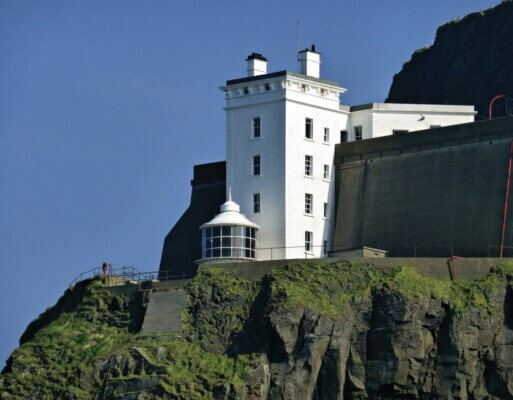
The main attraction is the Rathlin West Light Seabird Center, where you’ll be able to view thousands of birds, including puffins, razorbills, fulmars, and more.
The lighthouse is open during the month of April from 11 a.m. to 4 p.m. From May through August, it is open from 10 a.m. to 5 p.m., and during the month of September, it is open from 11 a.m. to 4 p.m.
Admission for adults is £5, £3.50 for students and £2.50 for children and seniors.
Search for a Car Rental in Ireland with Discover Cars
#3: Fanad Lighthouse, Co. Donegal
No blog post on 6 of Ireland's coolest lighthouses could leave out Fanad Lighthouse located on the Fanad Peninsula, an area of North Donegal that boasts spectacular scenery.
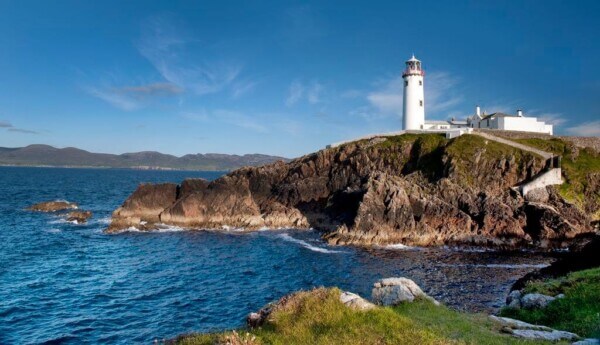
It stands between Lough Swilly and Mulroy Bay.
It is also in an area known as the Gaeltacht (“Gaeltockt”), where approximately 30 percent of the residents speak Gaelic (otherwise referred to in Ireland as “Irish”).
The 90-foot Fanad Lighthouse is one of the main attractions in the area and along the Wild Atlantic Way.
It consists of two separate dwellings connected to the central tower. The dwellings once served as the homes of the lightkeepers.
Today a caretaker is employed at Fanad Lighthouse.
A lighthouse was proposed for the area in 1812 after the HMS Saldanha was wrecked in the waters of nearby Lough Swilly, drowning all 253 people on board.
It was designed by one of the great civil engineers of the time, George Halpin.
On March 17, 1817, it was lit for the first time, with its light shining for 14 miles in clear weather.
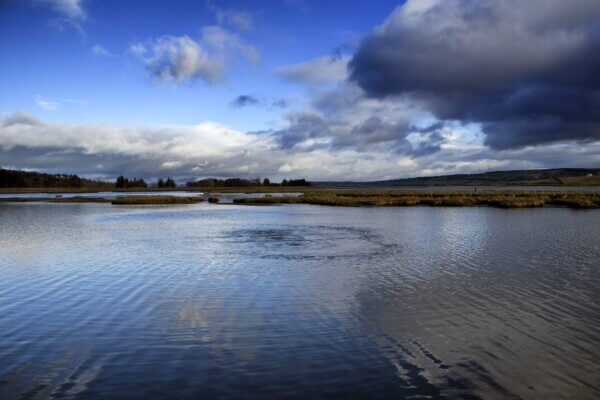
Go to the visitor center where you can sign up for a guided tour.
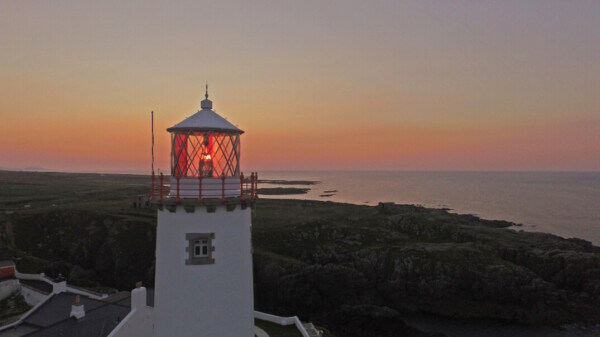
Admission is €13 for adults, €10 for studernts, and €6.50 for children ages 5 to 17. Guided tours of the lighthouse without visiting the tower are €6.50. The fee for a family of four is €32.50.
Opening times can be found on the website.
Fanad Lighthouse offers accommodation in the form of three self-catering “cottages,” where you’ll get a view from every window.
Prices start at €318 per house, with a minimum stay of 2 nights required.
During your visit to Fanad Lighthouse, why not take the half-mile walk or drive to Murder Hole beach?
It’s a secluded spot that could be a little tricky to find. It is close to the Melmore Head caravan park, but it’s best to locate it on Google Maps before you set off on your journey.
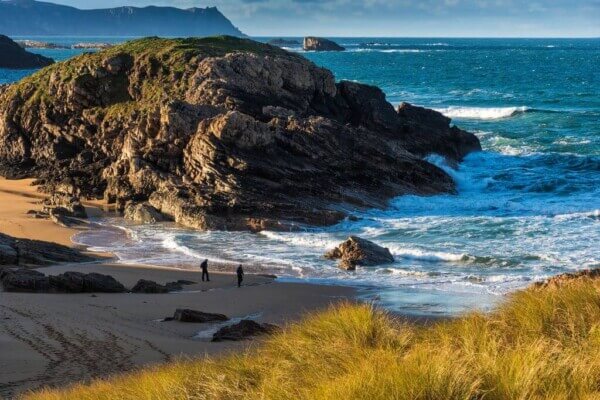
If you’re unsure of how to get to the beach, ask a local. You will have to walk through two fields to get to the beach. No dogs are allowed, and neither are drones. Photos must only be taken for personal use.
Get Wifi in Ireland with Wifi Candy – take 10% off with code IOB2024
#4: Hook Head Lighthouse, Co. Wexford
This lighthouse in Co. Wexford, located on the Hook Peninsula, was built 800 years ago.
It is the second-oldest operating lighthouse in the world and rightfully deserves to be on the 6 of Ireland's coolest lighthouses list.
Between 1210 and 1230, a light tower was built to guide ships coming into the port of nearby Ross. At the time, the light was fueled by coal.
Historians believe that many local people were involved in the building of the lighthouse tower, as well as skilled laborers from the Earl of Pembroke’s estate (Pembroke was also known as Strongbow or by his formal name, Richard deClare, an Anglo-Norman who became lord of Leinster).
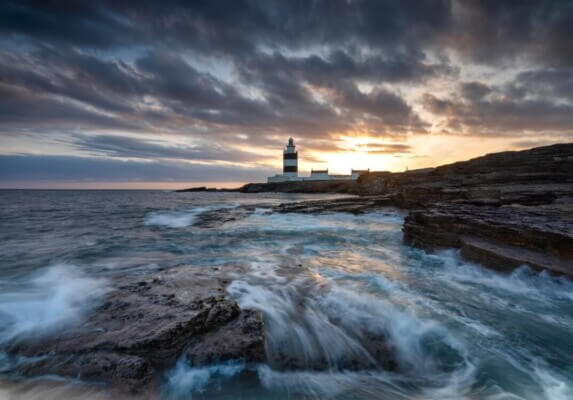
For several centuries, it looks like monks from the monastery at Churchtown served as custodians of the lighthouse until Henry VIII shut the monastery down in the 16th century.
A guided tour of Hook Head Lighthouse recalls this and much more about Wexford’s iconic attraction.
You’ll get to climb the 115 steps to the top of the tower, while costumed guides take you back in time through Wexford’s medieval history.
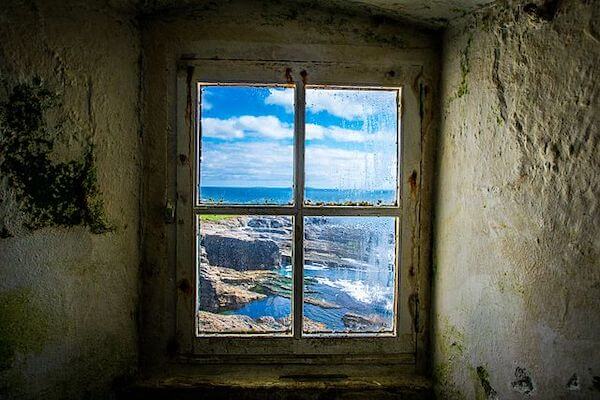
The lighthouse visitor center offers a number of themed group tours, including a sunrise and sunset tour experience, which costs €45 per person.
The lighthouse and visitor center are open year-round.
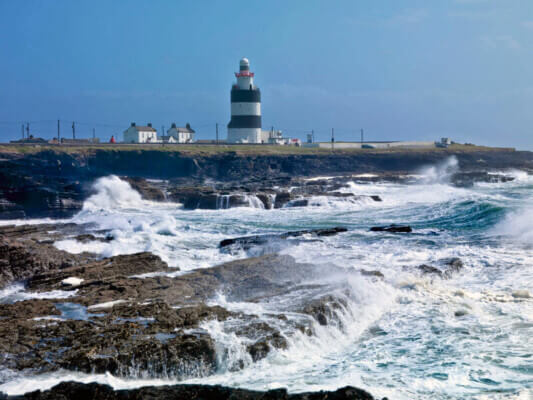
Admission is €10 for adults and €6 for children ages 5 to 18. You'll find more information on the lighthouse website.
There is no accommodation available at this lighthouse.
#5: Ballycotton Lighthouse, Co. Cork
In 1847, after the steamship Sirius struck a rock southwest of Ballycotton in dense fog, calls for a lighthouse on Ballycotton Island were strongly considered.
Sirius was the first steamer to attempt an Atlantic crossing.
Twenty people drowned in the disaster, while 70 survived.
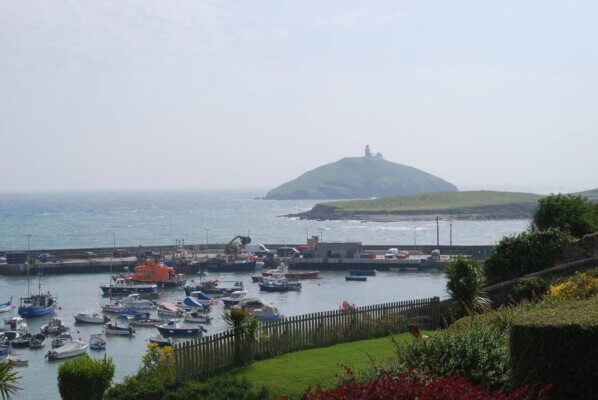
Shortly afterward, approval for a lighthouse on nearby Capel Island was given and construction did, in fact, go ahead.
Those plans, however, were quickly squashed when it was discovered that the rocks around Ballycotton were more treacherous, and so a lighthouse was much more urgently needed there.
The half-finished lighthouse on Capel Island still provides navigational aid to ships, but it is Ballycotton Lighthouse that really serves that purpose.
A black band was painted around the center of the Ballycotton Lighthouse in 1892 so that it would not be confused with the beacon on Capel Island.
In 1902, the whole tower was painted black.
You can only access Ballycotton Lighthouse by boat. Local company Ballycotton Sea Adventures provides boat trips and charters around Ballycotton Bay from April through October.
Once you get there, you can walk the original lightkeeper’s path to the top of the island and take a tour of the lighthouse, courtesy of Ballycotton Sea Adventures.

In addition to visiting the lighthouse, make sure to check out the island’s rich wildlife. You’ll see a colony of cormorants, peregrine falcon, in addition to plenty of seals and dolphins.
The lighthouse is open to tourists from April through October. Admission to the lighthouse is €27 for adults and €16 for children ages 3 to 12. A family ticket for four is €80.
#6: Valentia Island Lighthouse, Co. Kerry
The Valentia Island Lighthouse is built on the site of the 17th century Cromwell Fleetwood Fort, which safeguarded the island’s residents from invaders.
From the lighthouse, you can view the magnificent scenery of Ireland’s beautiful southwest coast.
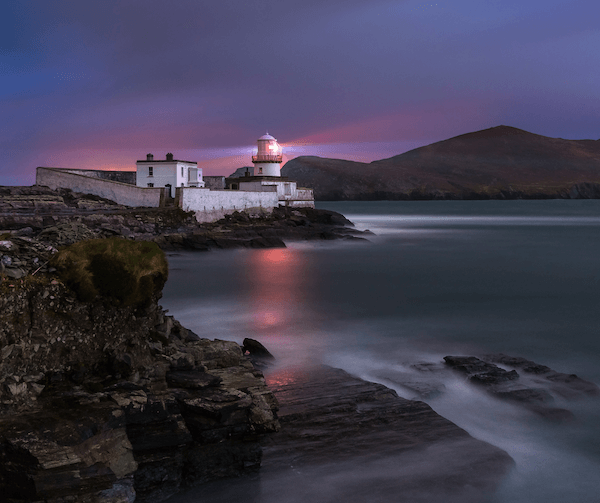
There are many signs of prehistoric life in the area, such as the fossilized footprints of a dinosaur that researchers believe stepped from the water onto land here over 300 million years ago.
A standing stone from the Megalithic period can also be found close to the lighthouse.
In fact, the whole island, like much of Ireland itself, has a variety of monuments from ancient times, including cairns, dolmens, wedge tombs, and Ogham stones.
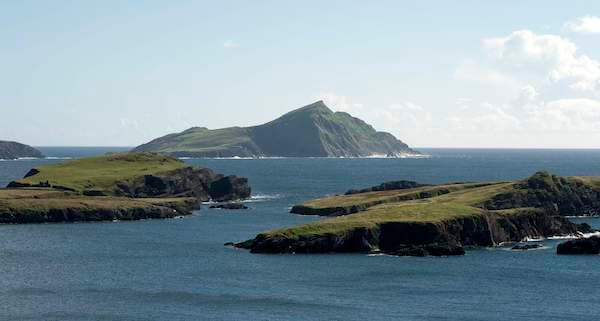
When the weather is clear, look for Skellig Michael, the UNESCO heritage site, as well as the Great Blasket Islands.
That alone warrants it being one of Ireland's coolest lighthouses.
You’ll also see where the first transatlantic cable was laid connecting Europe with North America in 1866.
A new visitor experience has been launched at the Valentia Island Lighthouse.
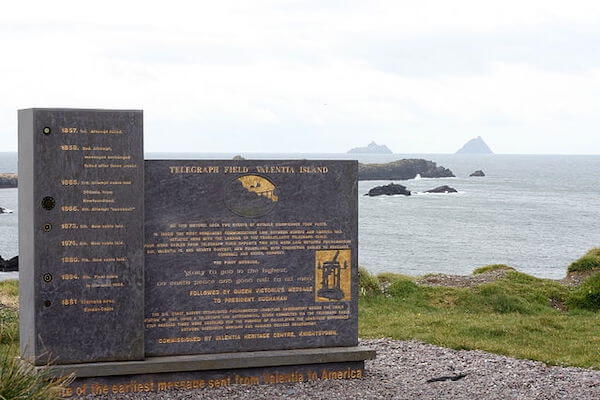
It includes a journey back in time, explaining to visitors the significance of the nearby Bronze Age standing stone, the 17th-century well-preserved Cromwellian fort, as well as a visit to the lightkeeper's 1920s-style house.
The lighthouse is open from March 29 through Oct. 27 for guided tours. Standard admission is €7.50 per person. Other rates include €20 for a family ticket, €4 for children under 12, and €6.50 for senior citizens/students.
About Valentia Island:
Valentia Island is a vibrant place that has a population of about 665 people.
It is one of Ireland’s most westerly points, connected to the mainland by the Maurice O’Neill Memorial Bridge. It is easily accessible from the popular Ring of Kerry tourist route.
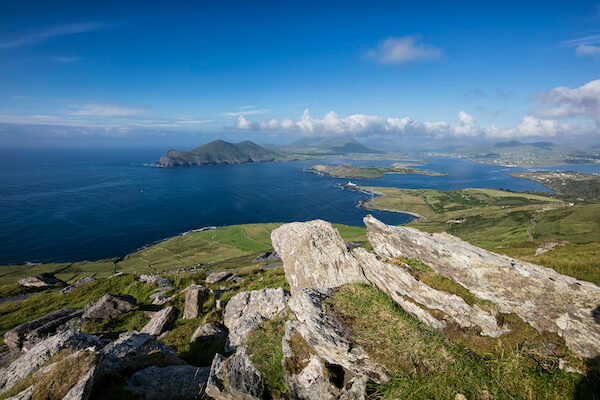
Here’s a map of the other attractions you can visit while on Valentia.
Have you visited any of Ireland’s iconic lighthouses? Let me know in the comments below.

